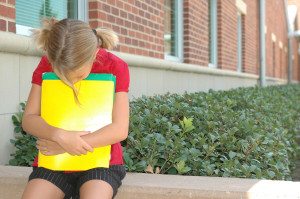 My family has gone through a lot of changes this summer. A lot. While many of us don’t like change (it’s hard, uncomfortable, unpredictable) at least as adults we are somewhat prepared for them. We know that the unsettling feeling is temporary. Adjusting takes time. Things will get easier. Etc. My almost four year-old daughter knows none of these things. We have totally uprooted her world by moving across country, leaving beloved friends, her first preschool, and the only home she has ever known.
My family has gone through a lot of changes this summer. A lot. While many of us don’t like change (it’s hard, uncomfortable, unpredictable) at least as adults we are somewhat prepared for them. We know that the unsettling feeling is temporary. Adjusting takes time. Things will get easier. Etc. My almost four year-old daughter knows none of these things. We have totally uprooted her world by moving across country, leaving beloved friends, her first preschool, and the only home she has ever known.
My daughter is certainly letting us know how she feels. Sometimes it has come through from her behavior (extra tantrums or increased bossiness- “You MUST do as I command!”) but she is verbally expressive, too. Frequently, while we are driving around our new town, I hear her little voice from her car seat in the back. “Momma, I’m sad.” “Momma, I miss California.” Even though I know these words were inevitable (even a good thing- she feels comfortable sharing these feelings with me) – they break my heart. I don’t want her to be sad. I want to fix everything and make it all better. NOW. No parent wants to see their child in pain. We have an innate, instinctual tendency to protect. It is what keeps our species alive.
So, with my parenting-instincts flaring and as someone with a propensity to “always see the cup half-full,” I have been literally pressing my lips together to refrain from giving her overly-cheery pep talks. You see, what I want to say is, “I know you miss California BUT isn’t it great how much closer you are to your grandparents?” “Sure you can’t play in your playhouse anymore BUT your new paddling-pool is so fun.”
The reason I am trying so, so hard not to do this (and I’ll admit I’ve slipped up a few times) is because I know how important *all* of her feelings are. They all serve a purpose. If my daughter doesn’t learn how to identify and acknowledge her feelings now, it will be increasingly more difficult for her to figure out how to cope with hard feelings when she’s a teenager and an adult. When intense emotions come up, I don’t want her to be blown over by them. I want her to know how to withstand them- even grow from the experience. If I can listen to my daughter’s feelings with empathy, she will learn that her feelings matter. They are hard but not devastating. If I minimize her feelings and introduce the “BUT” into our conversations, I invalidate her experience and even teach her that she should not have sad feelings. There is something wrong with her for feeling like this.
If you have seen the new Pixar movie Inside Out, you know that its subject matter maps pretty directly onto my own family’s recent experiences. I am a huge fan of the film. It is truly exceptional in its creative portrayal of five core emotions (joy, anger, sadness, fear, and disgust) which are personified into beings of their own. It identifies the purpose each emotion plays in a person’s personality formation and life experiences in a way that is understandable, humorous, and at times tear-jerking.
(Spoiler alert: If you haven’t already seen the movie- and don’t want any details, skip ahead to the next paragraph). In the movie, Riley an 11 year-old girl, moves from Minnesota to San Francisco due to her father’s job relocation. At bedtime, on one of the family’s first nights in their new town city together, Riley’s mother comments, “Through all this confusion, you’ve stayed our happy girl.” Because Riley’s father is stressed about work, she adds, “If we could keep smiling, it’ll be a big help.” As others have noted (including Dan Kois in his incisive 6/23/15 article on Slate.com), this movie is so powerful because it highlights how common it is to deny our children the right to express sadness. Riley’s mother is saying out loud the messages that are implicit in American culture all of the time: Sadness is bad- even dangerous. Get rid of it. The goal of life is to be happy. When a young child starts to cry, an adult’s first words are often, “Its ok. Don’t cry.” Why not? Maybe it is truly not ok. Releasing all the inner turmoil through a flood of tears may be necessary. By the end of Inside Out, the viewer learns that all emotions are important. Experiencing sadness means that you have lost something that was important to you. That something mattered. When Riley can admit to her feelings of sadness, she brings her parents closer to her and she is able to grow.
I posit that it is not only sadness that many Americans cannot tolerate. We struggle with all of the “negative” emotions. In my clinical work (as a child psychologist) I have observed that almost every person has one or two specific emotions that they are particularly triggered by. One parent may be particularly triggered when their child expresses anger. Perhaps for this parent, there is an implicit belief that if a child demonstrates anger she is being disrespectful or will become violent. Another parent, like Riley’s, may cringe at expressions of sadness.
What I see my most frequently in my clinical practice is the difficulty that parents have in holding their child’s anxiety. Because parents and children are so closely linked through their attachment-relationship, parents and children co-regulate each other. This means that when a child has an emotional response, the parent picks up on this at a physiological level. This occurs in the other direction, too. When a baby cries, a mother will often report that her heart begins to beat more rapidly, she begins to rush through whatever task she was doing, she may sweat. When a mother can maintain her calm, take deep breaths, rock the baby soothingly, the baby will become relaxed and content again.
We tend to remember how co-regulation occurs between parents and babies and forget it as children grow older. Because parents co-regulate their children and because children learn how to manage their emotions from their parents, a parent’s response is essential for the child’s outcome. Since a parent’s own anxiety may be ramping up as their child expresses concerns, a parent’s response often falls into one of two extremes as the parent tries to self-calm. One parent may try to solve the problem. “Why don’t you try this?” “Have you thought about that?” Another parent may dismiss the concern. “What are you talking about? That would never happen.” A more subtle form of this dismissal is to listen for a moment and then add in that insidious BUT to the conversation. (The way I’ve tried so hard not to all summer). “I know it’s scary BUT you can do it.” Neither of these approaches teaches the child how to self-calm and become more resilient in the future when stress and anxiety emerge.
In his book Raising an Emotionally Intelligent Child, John Gottman, PhD describes the steps of emotion coaching, which is an approach that helps children to build emotional intelligence and increase their resilience. In Emotion Coaching, parents accept all feelings, empathize and validate their child’s emotions, help their child to label their feelings, and collaborates with the child to problem-solve solutions. Research has demonstrated when parents use this approach, children are better able to self-soothe, control their impulses, self-motivate, and cope with life’s ups and downs.
If you are a parent preparing for the start of the school year, I encourage you to read Raising an Emotionally Intelligent Child and think about the ways you can emotionally support your child when he or she brings you concerns.
In my office, I hear a wide-range of anxiety-related concerns from parents, especially at the start of the school year. Parents may visit me because they have a young child who will not separate from them when it is time for preschool drop-off and instead will cling and cry for an hour. Parents of an elementary school aged child may come because their child has a tummy ache throughout the day, worries all afternoon about their homework, and then has difficulty falling asleep at night. Parents of middle school and high school children share the same scenario, “My child literally told me she thinks if she doesn’t get an A on the test, she won’t get into college. If she doesn’t get into college, she won’t get a job. If she doesn’t get a job, she will become homeless.” When parents come to see me for these reasons, their child’s anxiety has started to impact their day to day life. The child is not his-or-her bubbly self, he-or-she is are spending too much time worrying and not enough time having fun.
To help parents better support their children’s anxiety, I’m excited to be offering a new forum for parents this fall at Arbor Psychology Group in Plymouth. I’m going to be offering a workshop for parents who would like to learn ways to help an anxious child. The workshop will give parents an opportunity to share their experiences of their child’s anxiety and problem-solve ways of supporting their child that will improve their child’s ability to cope with anxiety in the future. The workshop will incorporate some of Gottman’s work as well as other research-based methods.
For more information about the parent workshop, click here.




